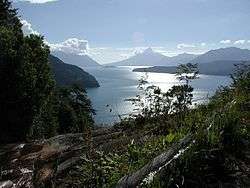Todos los Santos Lake
| Lake Todos los Santos | |
|---|---|
 | |
| Coordinates | 41°06′S 72°12′W / 41.100°S 72.200°WCoordinates: 41°06′S 72°12′W / 41.100°S 72.200°W |
| Type | monomictic |
| Catchment area | 3036 km² |
| Basin countries | Chile |
| Surface area | 178.5 km² |
| Max. depth | 337 m |
| Water volume | 34.4 km³ |
| Residence time | 4 years |
| Surface elevation | 189 m |
| Islands | one (Isla Margarita) |
Lake Todos los Santos (Spanish for "All Saints Lake") is a lake located in the Los Lagos Region of southern Chile, 96 km northeast of the regional capital Puerto Montt and 76 km east of Puerto Varas, within the boundaries of the Vicente Pérez Rosales National Park. It has a surface area of 178.5 km² and a maximum depth of 337 m.[1] The Lake's National Park status has ensured protection to its environment. The catchment is largely covered with old-growth Valdivian temperate rain forests. The present form of the lake is the result of glacial and volcanic processes.[1][2]
The main tributary of the lake is the Río Peulla/Río Negro, next to the Peulla locality. Its outflow at the Petrohué locality gives rise to the Petrohué River, with an average outflow of 270 m³ per second. Even though the lake has a regulating effect, it is subject to water level variations that may exceed 3 m and reflect in the discharge at the outflow. At a short distance from the Petrohué locality, the river flows through the Petrohué Waterfalls.
A regular road/boat transport service provides tourist transport between Puerto Montt/Puerto Varas in Chile and San Carlos de Bariloche on Nahuel Huapi Lake in Argentina. There are two main lake ports: Petrohué at the western end, and the village of Peulla at the eastern end; there is no road connecting these places. The lake is surrounded by steep mountains leaving only minor plains. Three snow-capped mountains are famous: the Osorno volcano in the west, the Puntiagudo to the north, and the Tronador to the east.

This lake has been known with various names in the past: Purailla, Pichilauquen, Quechocavi. In the tourist trade it is also known as Lago Esmeralda (Emerald Lake) due to the green color of its water. According to cloudiness and weather mood, the eye and the camera perceive the lake as green, blue or silvery.
References
- 1 2 "Lake Todos los Santos". World Lakes Database. International Lake Environment Committee Foundation. Retrieved 2014-01-19.
- ↑ "Cayutué-La Viguería". Global Volcanism Program. Smithsonian Institution. Retrieved 2006-10-27.
- (English) All on Lake Todos los Santos, Chile